You are here
The Sestiere of Castello
THE SESTIERE OF CASTELLO
2nd Itinerary
 The itinerary we recommend begins not far from St. Mark’s Square, in the spacious Campo di Santa Maria Formosa. This large square was once one of the liveliest places in town as well as being one of the oldest religious and civic centers of the Serenissima republic. In old times it was used for theatrical performances, and even for the feasts of the “bulls”, the cazze.
The itinerary we recommend begins not far from St. Mark’s Square, in the spacious Campo di Santa Maria Formosa. This large square was once one of the liveliest places in town as well as being one of the oldest religious and civic centers of the Serenissima republic. In old times it was used for theatrical performances, and even for the feasts of the “bulls”, the cazze.
The church of Santa Maria Formosa was built in 1492 with a classic-style 16th century façade facing the canal (included in the Chorus Circuit – concession with the Rolling Venice Card). This was the masterpiece through which its architect Mauro Codussi first achieved, in Venice, acclaim for the Tuscan plastic-spatial vision values of the Renaissance. The Latin-cross layout with three aisles is an overlay of the foundations of the 7th century church which, tradition has it, was one of the eight churches established by San Magno, Bishop of Oderzo, after the apparition of the Virgin in the form of a “magnificent matron” (formosa). The belltower instead dates back to the 1600s. Worthy of note inside are: the polyptych of Santa Barbara by Jacopo Palma il Vecchio (1480- 1510), in the Chapel of the School of the Bombardiers, a work that brought fame to the maestro, and the renowned Triptych of the Madonna of Mercy in the chapel of the Conception in Mantegna style, by Bartolomeo Vivarini from Murano island (1473). Among the other works in the Oratory is a “Madonna with Child” by Giandomenico Tiepolo (18th century).
At the southern end of the square is the Palazzo Querini Stampalia (discounted entrance with Rolling Venice) with its important library and one of Venice’s art galleries, donated to the city by its last heir, Giovanni Querini Stampalia in 1869. Its rooms, which also conserve some stuccoes and 17th century furnishings, contain works by such renowned Venetian painters from the 14th to 18th centuries as Giovanni Bellini, Palma il Vecchio, Luca Giordano, G.B. Tiepolo and Pietro Longhi to name only the most illustrious. The civic library open to the public has 300,000 volumes, of which about 32,000 can be consulted. There is also a truly impressive archive and library of manuscripts, incunabula, cinquecentine (16th century printing technique) and ancient volumes, geographical charts and antique plans. In the 1960s the ground floor and garden were redesigned by Arch. Carlo Scarpa while in the 1990s Mario Botta designed the new entrance, bookshop and coffee-bar.
A few minutes’ walk from Campo Santa Maria Formosa is Campo SS. Giovanni e Paolo (in older times San Zanipolo), the square dedicated to Saints John and Paul. It is also known as the Campo delle Meraviglie (Square of the Wonders), perhaps by virtue of certain prodigious events reputed to have taken place there although more probably for its being perhaps the most monumental of Venice’s squares after that of St. Mark. The center of the square is dominated by an imposing equestrian statue - considered to be one of the world’s best - commemorating the famous leader Bartolomeo Colleoni, who served the Serenissima Republic for over two decades. The statue (1491-96) is by the Florentine Andrea Verrocchio - maestro of Leonardo da Vinci, no less - and was originally intended to be placed (by express wish of Colleoni) in St. Mark’s Square, were it not for a law that prohibited that square from receiving monuments of private citizens. A workaround solution was thus contrived to nevertheless confer a place of prominence to the statue: not opposite the church of St. Mark itself, but in front of the school dedicated to the city’s patron saint. What is today the city’s main hospital was indeed formerly the seat of the Scuola Grande di San Marco (Grand School of Saint Mark), one of Venice’s six confraternity (sodalities or confraternities) with the mission of providing assistance and compassion to the poor and needy. The façade materwork dates back to the late 15th-early 16th centuries and is the work of Pietro Lombardo and Mauro Codussi, two of the most renowned architects of the Renaissance to have worked in Venice. Of great effect are the two perspective panels with trompe d’oeil images depicting two lions that appear to be guarding the main entrance.
But it is the Basilica of SS. Giovanni and Paolo (or San Zanipòlo) itself that dominates the square. Begun in late 1200 and completed about two centuries later, it stands as one of the city’s most imposing gothic buildings. It is often referred to as Venice’s Pantheon, for the number of funeral monuments honouring doges (17 in all) not to mention all the other illustrious persons resting therein. Curiously, this monumental church lacks its belltower, a fact dating back to the 14th century. It has been replaced by the side bell tower we see today. The interior of the building conveys an effect of the “immense”: the awe-inspiring structures are all enveloped by a suffused light that filters through gigantic windows; the array of paintings and sculptures to take in is little short of bewildering. On entering, along the right nave is the funerary monument to Marcantonio Bragadin, the hero of Famagusta, skinned alive by the Turks in 1571 (the macabre relic of his skin in the urn was greatly honoured by the State). Among the many interesting works in the church - including a rare 15th century stained glass window - is the polyptych of San Vincenzo Ferreri by Giovanni Bellini and some masterpieces by Paolo Veronese in the chapel of the Rosary (commemorating the battle of Lepanto, which saw the Venetians victorious over the Turks in 1571). From Campo SS. Giovanni e Paolo, walking along Salizzada SS. Giovanni e Paolo and immediately after Barbaria delle Tole, is Rio di Santa Giustina. After crossing the bridge and keeping to the left, we reach Campo San Francesco, which took its present form in the second quarter of the 16th century, during the period when St. Mark’s Square was reorganized.
The square is dominated by the 15th century church of San Francesco della Vigna built on a design by Jacopo Sansovino, with its subsequent classic-style façade by Andrea Palladio (1564- 70). After the ill-starred beginning of San Pietro di Castello (point 12 of this walk), it was in fact Daniele Barbaro again who favoured using Andrea Palladio in Venice. He persuaded Giovanni Grimani, Patriarch of Aquileia, to pay Palladio to design this façade, thereby de facto unseating Sansovino, who had been in charge of works to the church for the last 3 decades (after the renewal of St. Mark’s Square, he was considered too elderly). The vast interior is replete with works of art: at the first altar of the right transept is an enthroned Madonna adoring Child by Fra’ Antonio da Negroponte (circa 1470); in the presbytery are funeral monuments of Doge Andrea Gritti and his circle, perhaps by Sansovino; in the chapel on the left of the presbytery are sculptures by Pietro Lombardo and pupils (1495-1510); in the Santa chapel, which can be entered from the left transept, is a Madonna with Child and Saints by Giovanni Bellini (1507); and in the 5th chapel on the left is a Sacred Conversation by Paolo Veronese (circa 1551). Wandering among the alleys, in the less-elegant zone adjacent to St. Mark’s Square from Campo di San Francesco della Vigna to Ramo Ponte San Francesco and Salizzada San Francesco towards the Riva degli Schiavoni and the Basin of St. Mark’s, passing S. Antonin, is a jewel of Gothic style: the Church of San Giovanni in Bragora. Set in the beautifully evocative Campo Bandiera e Moro or “della Bragora” (of baffling ethymology, deriving perhaps from the ancient brago and gora which indicated the square’s originally-muddy terrain or perhaps from agorà, square in Greek), this area was already inhabited in pre-Doge times. The church was rebuilt in 1475 and has a characteristic brick façade. The interior, with three aisles, has some important paintings: on the wall of the right aisle by the vestry door is Constantine and his mother Helena by Cima da Conegliano (1502); the Risen Christ by Alvise Vivarini, a Triptych with Madonna enthroned between Saints Andrew and John the Baptist by Bartolomeo Vivarini; and Francesco Bissolo’s triptych of the Saints Andrew, Jerome and Martin. In the presbytery, with its ornate vault of stuccoes by Alessandro Vittoria (1596) is a Baptism of Christ by Cima da Conegliano (1494) and, on the right wall, a Last Supper by Paris Bordon. In the left aisle we can also admire the Madonna praying with Child (1490) and a small painting on wood with Head of the Redeemer (1493), both by Alvise Vivarini.
Towards St. Mark’s, facing onto the Riva degli Schiavoni and only a short distance from Campo Bandiera e Moro, also the Church of the Pietà or of Santa Maria della Visitazione is worth visiting. From the mid-1300s, with the annexed building, it was one of the best-known orphan hospices and it was here that maestro Antonio Vivaldi directed the orphans choir for three decades in the 18th century. Vivaldi was dubbed “the red Priest” for his flaming hair, scarlet robe or perhaps for his fiery character. The current church dates back to 1760. Behind the Pietà, at the end of Calle Bosello, is the Church of S. Giorgio dei Greci and the Hellenic (Greek) Institute (concession with Rolling VC), the seats of the Greek orthodox community, which was the most important foreign community of the Venice Renaissance. The Greek Institute in the Flangini College contains about 80 Byzantine and post- Byzantine icons, sacred furnishings and other religious items. By continuing along the Fondamenta Ca’ di Dio and immediately after the bridge, we reach the Arsenale (only from the outside: the navy complex is not open to visitors) or, time permitting, visit the Naval History Museum. To begin this visit in style, we recommend walking along the Salizzada del Pignater and Fondamenta di Fronte to admire the entrance of the Arsenale, which is a grand complex of shipbuilding workshops dating back to the 12th century. Enlarged several times over the centuries, the Arsenale was the hub of the Serenissima’s marine power. The entrance from land is marked by a portal (1460), thought to be the first work of the Venetian Renaissance, surmounted by an attic with a large lion of Saint Mark attributed to Bartolomeo Bon. A terrace decorated with Baroque allegorical statues was built in front of the portal in the period 1692-94. To the sides of this are two stone lions originating from Greece (the left one was in the port of Pireus). Farther to the right are another two smaller lions, one of which hailing from the island of Delos. The Arsenale area contains buildings of notable architectural and historical interest among which: the building of the Bucintoro (in the old Arsenale), a Doge’s boat-shed; the Gaggiandre (new Arsenale dock), two impressive wet shipyards built in the period 1568-73 on a plan attributed to Jacopo Sansovino; the 300 metre long Rope yards (Corderie) of the Tana (southern side of the Arsenale), where the hemp was kept and twisted to make the ships’ ropes (used today for temporary exhibitions).
From here you can return to the itinerary from Via Garibaldi. Near the open waterfront of Riva degli Schiavoni, in Campo San Biagio is the Naval History Museum (discounted entrance with Rolling Venice), a visit to which provides the opportunity to experience Venetian naval power close-up. With relics, models, engravings and models, the museum traces the history of the Venetian navy (16-18 centuries) and the Italian Navy from 1860 to the present day. Of particular interest is the model of the Bucintoro, a splendid galley the Doge used when celebrating the Republic’s union with the Sea; a large model of a fifteenth-century Venetian galiass; models of frigates and vessels of the 1700s. A separate section of the museum, with real historical boats, is found in the Officina Remi (oars workshop).
The last section of the trip takes us to discover 12 of the islands and to Church of San Pietro di Castello (included in the Chorus Circuit, discounted entrance with Rolling VC). Following the itinerary we have suggested, in a few minutes from Via Garibaldi you will reach an evocative zone set apart from the tourist trail at the eastern end of the main island, behind the Arsenale complex. From the 8th century until the beginning of the 19th century, it was the seat of the city’s religious power. Here stands the church of San Pietro di Castello, which until 1807 was Venice’s cathedral (Patriarchal church). Of ancient origin (9th century) it was restructured several times and rebuilt in the 16th-17th century. It has a monumental façade dating to 1594-96 and a separate belltower, designed by Mauro Codussi (1482-90), both in Istrian stone. The plan of the façade is attributed to Andrea Palladio and his first commission in Venice, on recommendation by Daniele and Marcantonio Barbaro, the guarantors of the contract with the bricklayers in January 1558. The death of the patron, Patriarch Vincenzo Diedo, halted the works two years after their beginning; they were completed only nearly 40 years later, in 1596. Although today’s building does not respect Palladios plan exactly, it is faithful to its guiding principles and in particular to the interaction between a greater order corresponding to the nave and a smaller one, relating to the side ones, which was later fully completed at San Francesco della Vigna.
we have suggested, in a few minutes from Via Garibaldi you will reach an evocative zone set apart from the tourist trail at the eastern end of the main island, behind the Arsenale complex. From the 8th century until the beginning of the 19th century, it was the seat of the city’s religious power. Here stands the church of San Pietro di Castello, which until 1807 was Venice’s cathedral (Patriarchal church). Of ancient origin (9th century) it was restructured several times and rebuilt in the 16th-17th century. It has a monumental façade dating to 1594-96 and a separate belltower, designed by Mauro Codussi (1482-90), both in Istrian stone. The plan of the façade is attributed to Andrea Palladio and his first commission in Venice, on recommendation by Daniele and Marcantonio Barbaro, the guarantors of the contract with the bricklayers in January 1558. The death of the patron, Patriarch Vincenzo Diedo, halted the works two years after their beginning; they were completed only nearly 40 years later, in 1596. Although today’s building does not respect Palladios plan exactly, it is faithful to its guiding principles and in particular to the interaction between a greater order corresponding to the nave and a smaller one, relating to the side ones, which was later fully completed at San Francesco della Vigna.





